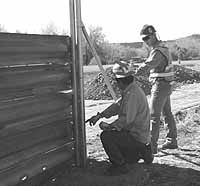| Workmen toil on game crossing structure during a project on U.S. Highway 6 between Helper and Blue Cut in spring 2002. UDOT is exploring the possibility of constructing similar structures and fencing along U.S. 6. |
As the environmental impact statement on U.S. Highway 6 is readied for public comment, the Utah Department of Transportation has many different areas that require study.
Two of the areas, the selection of the proper median dividers for various areas and providing wildlife crossings in some places, are some of the most important issues that are being considered.
Median dividers come in all kinds of configurations, with some areas of highway in Utah using two kinds in the same place.
Probably the most effective way to divide lanes from one another is space, according to the transportation department.
There are areas along Interstate 70 between Richfield and Cove Fort as well as between Cove Fort and Beaver along with other places where space is used very extensively.
In some cases, elevation changes are used. However, space between lanes requires large expanses of right of way and the physical characteristics of the landscape to allow it.
UDOT has divided sections of the highway as the road runs between Spanish Fork and Green River into two areas.
The western median segment-from Spanish Fork Canyon to Helper and the eastern median segment, from Helper to I-70.
In the western segment the median is planned to be 14 feet wide with some type of center barrier to minimize cross over collisions.
Center barriers could be concrete, made of standard guard rails or be of a cable design.
On the eastern segment, the plan calls for a 65-foot wide expanse between travel lanes with natural landscaping because flatter ground exists at the site.
No barriers will be located on the eastern segment. However, should there be areas where the space divider is less than 40 feet for some reason, barriers will be installed.
Barriers often present a new set of problems for highway designers because of the impact on various aspects of road operation.
While it is better for a vehicle to hit a barrier than another car, they can also, if not designed properly, create accident hazards as well, according to the transportation department.
Another problem barriers cause, particularly where narrow even grade dividers exist, is the situation with snow removal. It is difficult to find places to put snow on the left side of the inner lane when the white stuff piles up.
In addition, once snow is piled on a barrier, it is hard to remove it, and the melt down over short sunny winter days can create black ice problems on the opposite long dark nights.
Barriers can also create problems for wildlife, another area that UDOT intends to address in the U.S. 6 corridor. Plans for various areas along the road call for different solutions in each.
From Moark Junction to Soldiers Summit, the plans are for new game fencing which discourages wildlife from crossing the road.
In conjunction with the fencing between Moark Junction and Thistle Junction, UDOT is planning some culvert improvements so that big game can use them to cross underneath the highway.
Between Thistle Junction and Tucker, the state agency plans to build four big game underpasses, one place at a railroad crossing to an underpass, a compatible stream crossing and to also covert some existing culverts for big game crossings.
From Tucker to Soldier Summit the agency plans for new fencing on three miles of the corridor, one new big game over pass and some conversion existing culverts for underpasses.
From Soldiers Summit to the Peerless port of entry ,UDOT is planning for one big game overpass, culvert conversions for underpasses as well as two predator underpasses.
From Peerless into Helper, the transportation department plans for a two mile extension of big game fencing and one modification of a railroad crossing into a big game overpass.

